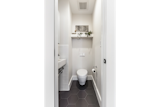What's the Best Way to Save Space in a Small Bathroom?
If you have a tiny bathroom at home that you're unsure how to remodel for maximum efficiency, you're not the only one. We turned to some seasoned architects and designers from the Dwell Pro Index for some pointers.
1. Take advantage of wall-hung fixtures.
Jessica Johnson, SF Design/Build:
We converted an old closet into a half-bath without an inch to spare! When it comes to a bathroom as small as the 14th Avenue bath, it's important to use wall-hung fixtures so the space feels lighter. The wall-hung toilet and sink also create an easier-to-clean space, which is an added bonus.
2. Consider ways to integrate elements and eliminate boundaries.
Courtney Nye, Courtney Nye Design:
[This] is a project I had with a very small footprint—this was their master bath—and there was not much space we could take from a nearby room to grow the footprint, but we were able to gain two feet in room length. This bath was 65 square feet after gaining the extra two feet.
I've found that what helps the most for smaller spaces is to try to build in or integrate some elements together, and to also create a walk-in shower if possible. For the bath below, in order to get more counter space, we mounted a wall-hung toilet onto an extended cabinet. We also built in a recessed medicine cabinet with integrated mirror and lighting, which housed various functions with a continuous flow. A larger mirror helps as well. For the walk-in shower, we dropped it to a zero clearance so the room just visually continues that extra bit, and did a glass shower panel instead of an enclosed door.
3. Free up as many surfaces as possible.
Aaron Leshtz and Harper Halprin, HH Design:
In any small space, every inch has value—we try and maximize that value by freeing up as many surfaces as possible. Integrated hardware frees up a vertical surface, reducing the overall depth of the vanity. Floating the vanity frees up the floor, visually expanding the room. Wall-mounted plumbing fixtures free up your countertop, and shallow shelving gives you more space for every day essentials or a few succulents (bonus points for bringing greenery into a window-less room).
4. Strategically use color, materials, and views.
Peterssen/Keller Architecture:
The powder room in the Huntington Residence is a great example of one of the strategies that we employ in small modern spaces: bringing in natural light and views. Supplementary to the large window in the cozy powder room, we worked with the interior designer to select a slate tile for the wall that adds depth and texture to be in contrast with the modern, clean-lined appliances. The blending of the interior and exterior that happens in this space makes it feel much larger than it actually is.
In the Sheridan Residence’s master bathroom, the small rectangular space is transformed into a highly functional on-suite through color blocking, natural lighting, and glass partition walls. By simplifying the color palette and bringing in natural light, the space is visually simplified while still full of program and storage. A glass partition wall is used to separate the shower from the main space, allowing for the room to read as one larger space.
5. Capitalize on natural light.
Neal Schwartz, Schwartz and Architecture:
At S^A we always try to integrate natural light into even the smallest of bathrooms to maximize the sense of openness, lightness, and space. Even if the light source is small or somewhat hidden, the changing quality of light over the course of the day has a dramatic impact. If natural light isn’t an option, we can replicate the feel with artificial light coming from a recessed or hidden source.
6. Know the minimum size requirements—and then get creative.
Jonathan Taylor from Taylored Architecture:
You can really get a lot out of small spaces and save a substantial amount of money on construction costs by first understanding absolute minimum size requirements for necessary fixtures (such as the shower, sink, and toilet for a full bath) and then getting creative with layout and storage opportunities.
Inviting natural light—either via a traditional window, skylight, or light tube—is another great way to make a small space feel more inviting and spacious. Additionally, utilizing oversized mirrors helps to create the illusion of a greater space; pocket doors help to make small spaces function better; and using oversized, vertically oriented tile makes the space feel taller.
Also, eliminating a shower door, using a clear glass sliding shower door, or a transparent shower curtain are also viable solutions.
Published
Get the Dwell Newsletter
Be the first to see our latest home tours, design news, and more.














